Asia has the best food. Period. No arguments. Every time I state this unequivocal fact, Victor tries to mumble something about Mexican food, then realizes that I am willing to physically fight him over this and quickly changes his tune. And so, Victor and I agree - Asia does have the best food. We ate our way through Thailand, Cambodia, China, Japan, and India, and thought nothing could surprise us at this point. Especially not Vietnam. Vietnam, I always thought, borrowed its culture from China and its food from Thailand. Not for the first or last time in my travels, I was very wrong.
Vietnamese food, while based mostly on the same ingredients as Thai, Cambodian, and Chinese, is very distinct from its neighbors and, dare I say, one of the best cuisines in Asia. One of the most distinguishing characteristics of Vietnamese cuisine is the fact that you can go days of eating breakfast, lunch, and dinner and not once see a side dish of rice. Are we still in Asia? How can this be? Where is the white, fluffy, steaming rice? It’s actually right there on the plate, masquerading as long, translucent, and often hopelessly tangled rice vermicelli. Of course, there are plenty of dishes with rice, but somehow, no matter how many different dishes we ordered, we almost always ended up with rice vermicelli. I hope I don’t sound as if I am complaining because that stuff is delicious! And here’s a kicker. One of the most popular foods in Vietnam? It’s a sandwich. On a baguette. I’ve never seen sandwiches in Thailand or Cambodia or China, except in Western establishments. In fact, just to satisfy my own curiosity, I googled “sandwiches in Thailand” and a TripAdvisor posting claimed a local restaurant as having “Best Sandwiches in Thailand”, and right below that, “This location was reported as closed”.
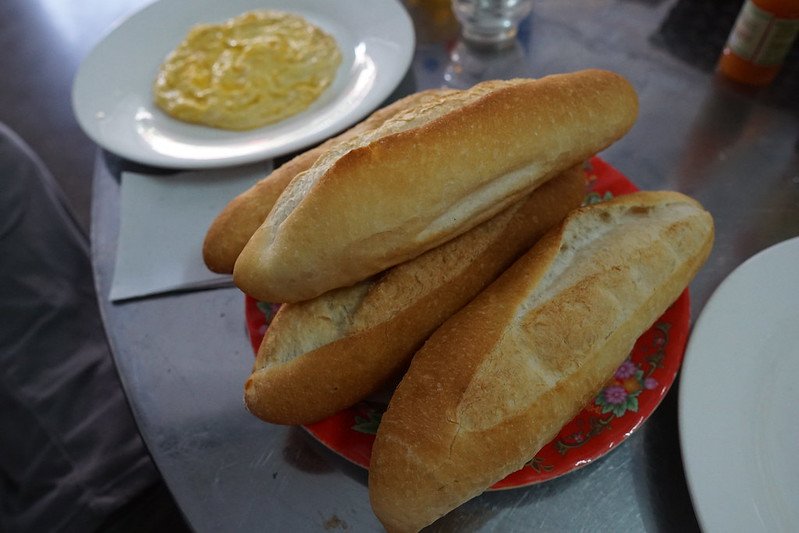
But let’s take it one delicious dish at a time. The one and possibly only Vietnamese dish I tried before coming to Vietnam was pho (pronounced as “fa:”). The rich beef broth, the tasty rice noodles, the bean sprouts, the sweet basil, the lime, I ate it all to the last drop. And here’s the first issue - apparently, I wasn’t supposed to. The first few days in Vietnam, we were both very confused by a half-filled bowl of pho all the locals were leaving behind on tables. Were they not hungry? Was this pho not very good? We licked our bowls clean until finally Minh, our trusted motorbike guide in Hue, explained that broth in Vietnamese soups is simply a way of keeping the noodles and meat moist and flavorful and is occasionally slurped, but never fully consumed. It was definitely a lightbulb moment for us. If the previous two sentences make it sound like we stopped licking our bowls clean, I assure you, we did not. Pho is delicious, and it’s hard to stop, and don’t tell me how to live.
One of the best bowls of beef pho I ate in Hanoi, the birthplace of this dish, in a tiny café located in a narrow alley, jammed between two buildings. We arrived first thing in the morning, and the line of locals was already spilling out of the alley into the main street. The only thing on the menu was beef noodles or double beef noodles. There was also an old man selling quays, fried breadsticks, which were absolutely delicious when dipped and dropped into the amazing flavorful broth. There was only one large family-style metal table on site, but it’s possible that there were more tables down the alley. Some people just ate standing up or leaning on their motorbikes. I was lucky enough to get a seat next to a large, friendly Vietnamese family at the large table. They watched me curiously, smiling encouragingly at me. I did not envy them. These people were about to see someone eat an entire bowl of pho, including all the broth, on what started as a regular Saturday morning for them. This was going to be a cultural experience for everyone at this table. Luckily for all of us, they finished their meal before I did and left their half-eaten pho at the table, as I was ravenously slurping my way through the bowl. Victor, who did not get a seat at the table, stood further down the alley pretending not to know who I was.
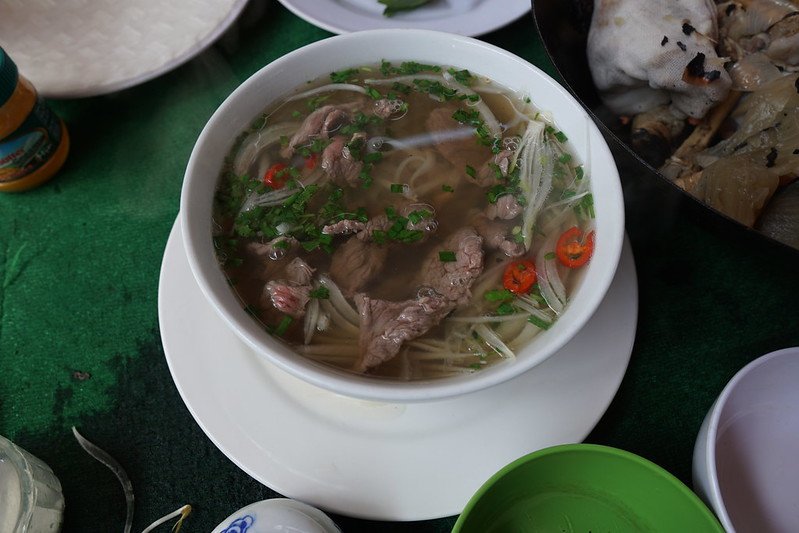
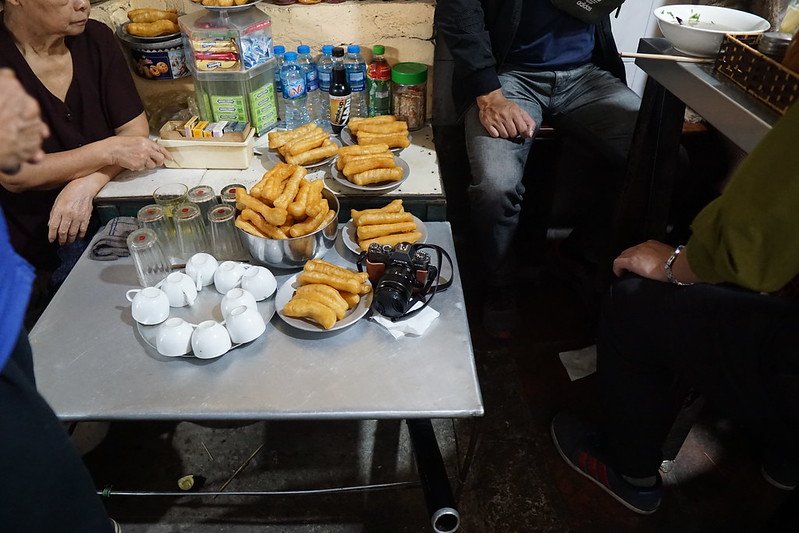
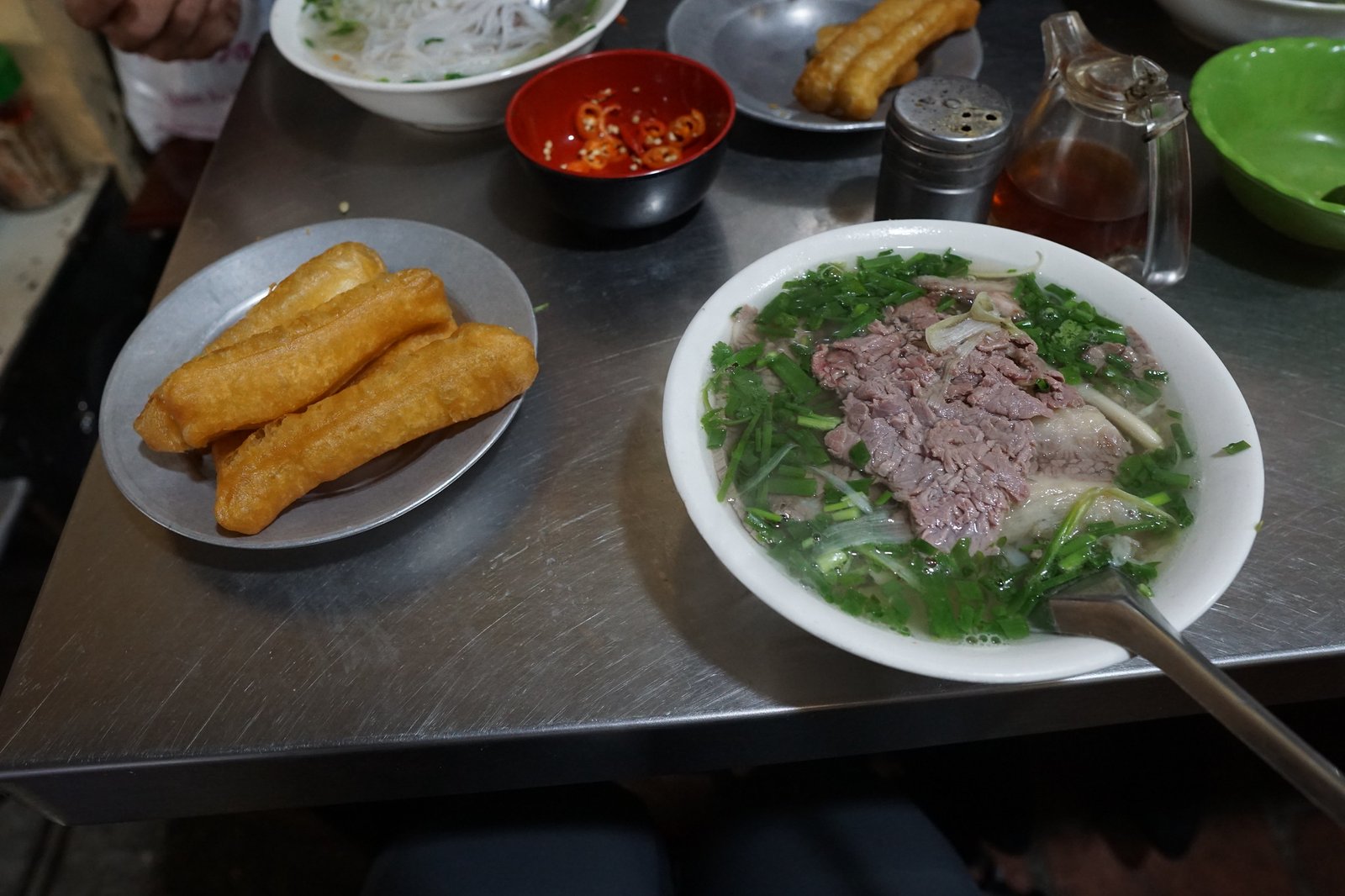
My next favorite food that we also tried over and over again in Vietnam is bun cha. Initially, all the main components look just like pho – broth, meat, rice noodles, greens, and lime. But the broth is actually sweet fish sauce, the meat is fatty pork, and all ingredients are served separately, to be dipped and poured, and mixed at the table by the customer. The result was mouthwatering every time. One of the bun cha places we visited was “Bun Cha Ta” in Hanoi, which is considered to be one of the top bun cha restaurants. There is another place where President Obama ate bun cha with Anthony Bourdain during his Vietnamese visit, but that one is now overrun by tourists. Bun cha is usually lunch or dinner food, but we were in that area in the morning and decided to have it for breakfast. When we walked in, the place was barely open, and one of the waiters had her motorbike right in the middle of the restaurant, unloading groceries from it. We squeezed around the bike and took our seats in a comfortable booth. Pretty soon, the restaurant started filling up with other patrons, and every table looked the same – a plate of wild greens, crystal clear noodles, a dish of sauce and submerged meatballs, and a small plate of fried spring rolls.
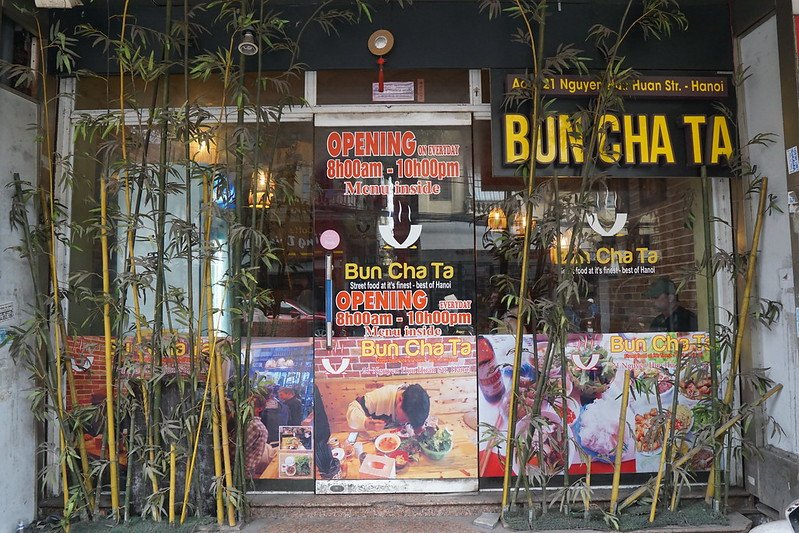
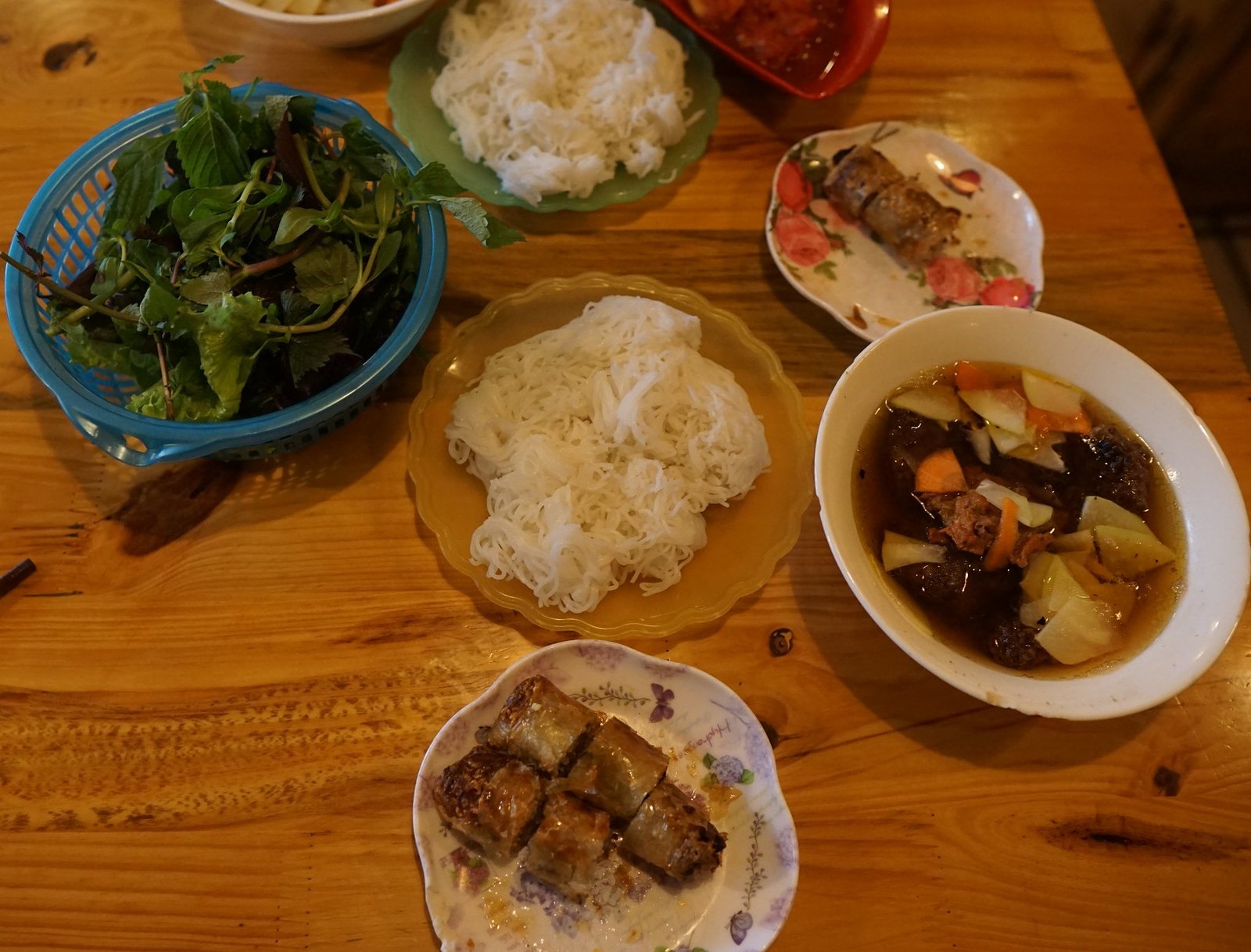

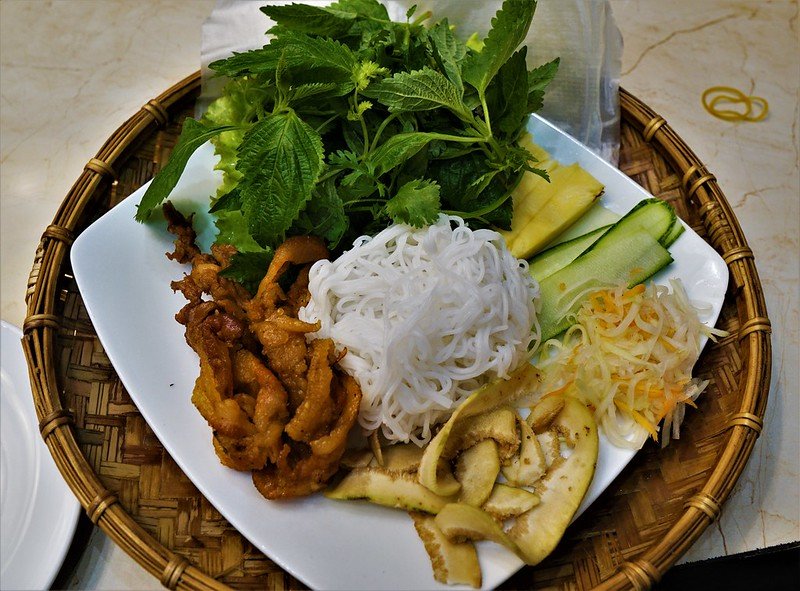
But the most popular dish in Hanoi is cha ca -- crispy turmeric-marinated fish that's fried tableside in a pan. As always, there is a side of rice vermicelli, fresh herbs such as dill, basil, and spring onion, a saucer of fermented shrimp paste, along with roasted peanuts and chili. Cha ca was initially invented by a local family who served local river fish, snakehead, to the troops during French colonial rule. As the popularity of the first restaurant grew, dozens of cha ca eateries opened on the same road, and eventually, the road itself was officially renamed Cha Ca Street. While our waiter did show us what to do, the actual process of frying was left up to us. And I must say – we are certainly masterful cooks, or at least we were on that day. The fish came out crispy, tender on the inside, and the combination of herbs, turmeric, and fish paste lent the dish a musky, savory taste.
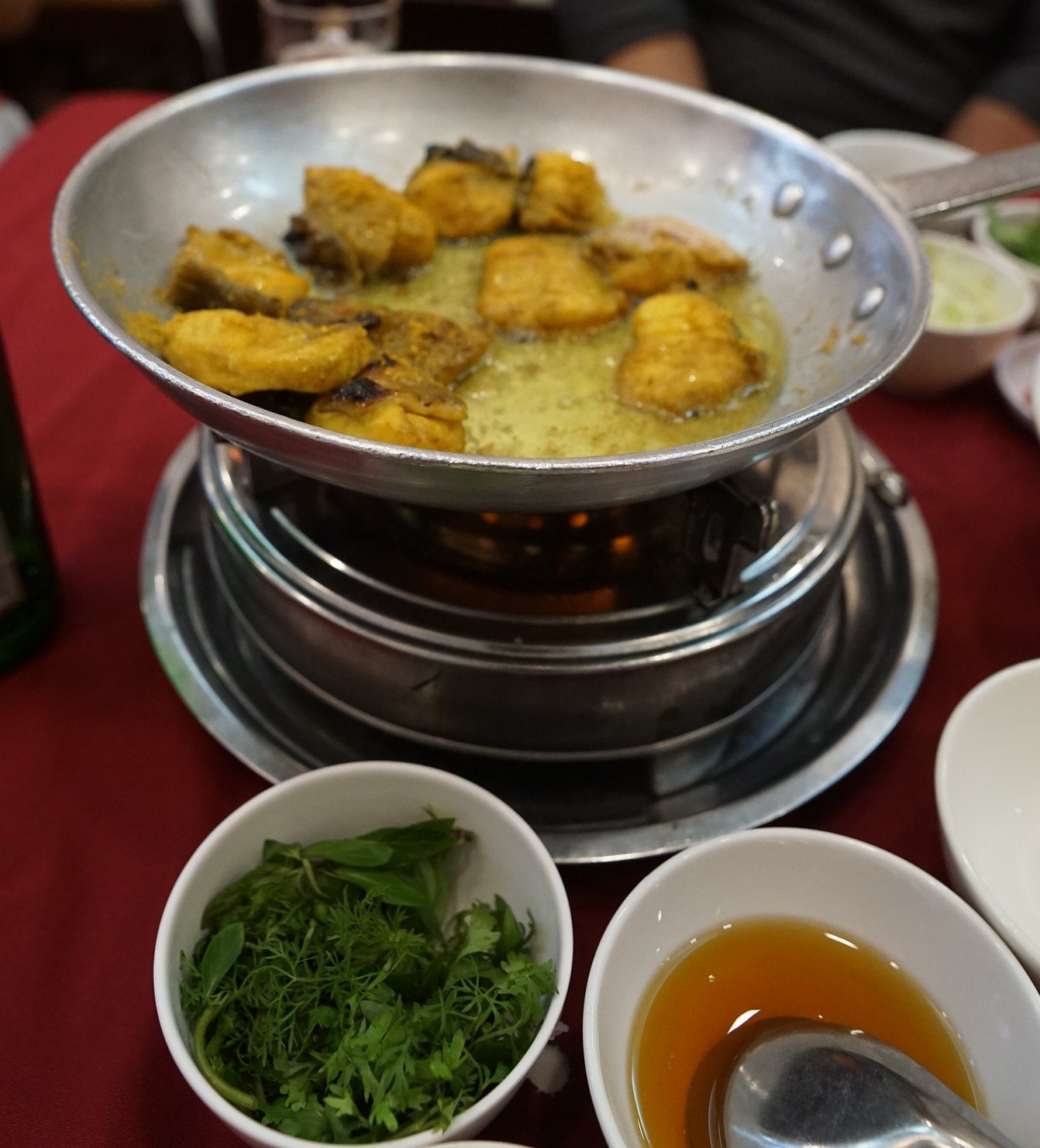
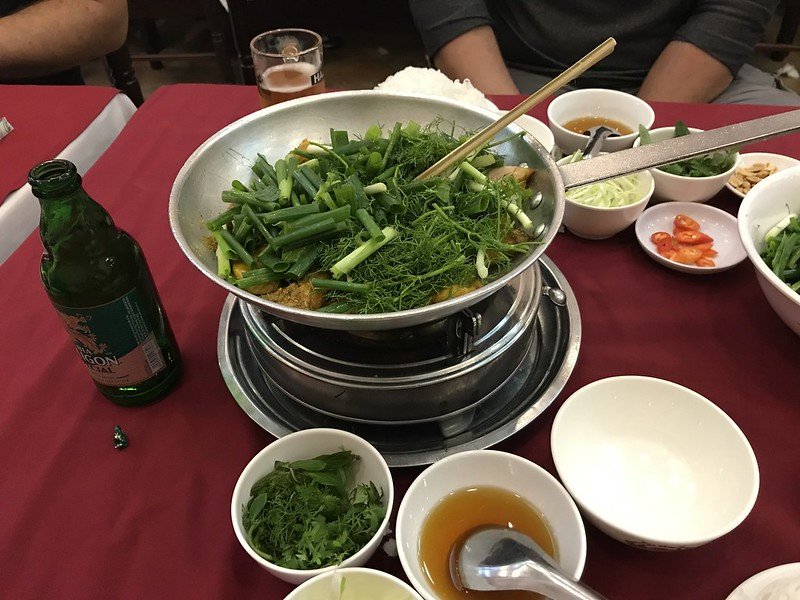
I already mentioned the confusing concept of an Asian sandwich, so here it is the ever-present bahn mi. We saw bahn mi in every city, in the tiny stall and large restaurants, eaten on the street and on posh balconies. We saw it, we ate it, we agree with all the enthusiasm Vietnam has for the abundance of roasted meat, shredded vegetables, and pate on a chewy, soft baguette. Turns out the word “banh mi” in Vietnamese simply means “bread”, which is intrinsically understood to mean “Vietnamese baguette” as that’s pretty much the only kind of bread usually sold in Vietnam. Unsurprisingly, this bread was introduced by French colonists when Vietnam was still part of French Indochina but has changed since those times. Rice flour started being mixed in making the bread fluffier, and the shape of the bread is usually shorter and messier than its French cousin. Because baguettes go stale rather quickly, they are baked every morning and afternoon, and the smell of freshly baked bread is always wafting through the air. In Hoi An, while walking to a tailor's measuring appointment, we came across a long line spanning several blocks. Despite Vietnam being a Socialist country, we’ve never really seen food lines or any kind of lines. Intrigued, we followed the queue of locals and tourists and found that it led to a tiny bahn mi shop. There must have been half a dozen almost empty bahn mi concession stands and restaurants on the same street, so this was one hell of an advertisement. We came back later that night and got in the back of the line, which only seemed to get longer as the day went on. Turns out this was the place Anthony Bourdain made popular by claiming it had the best bahn mi sandwiches in Vietnam. I’ve never disagreed with Anthony Bourdain before, and I won’t start now. That bahn mi was absolutely delicious and easily one of the best meals we had in the whole of Vietnam. I ate a mixed bahn mi with pork, headcheese, pate, carrots, cucumbers, mayo, and god knows what else all jammed in the chewy baguette, while Victor devoured a veggie bahn mi with marinated tofu and claimed it was a life-elevating experience. That one veggie bahn mi is the entire reason for this post, as Victor refuses to stop talking about it every time we discuss what needs to be written down about our Vietnam trip.

The last dish worth mentioning is not a dish or even food at all. It is, in fact, coffee. Vietnam is one of the world’s largest producers of Robusta coffee, which has a stronger, bolder taste than the popular Arabica strain. But it’s not just the beans. The usual cup of joe in Vietnam is served with a very generous portion of sweet condensed milk, making it more of a dessert than a drink. We drank it every day, trying not to think of the calories ingested with every sugary portion. But we are not talking about the usual cup of coffee here. The coffee that caught my eye on the menu one day was called “egg coffee”. Unsure if this was a translation error or a very strange dish, I ordered a cup. What arrived was a very pleasant cup of hot coffee with a thick caramel-tasting custard topping. It was delicious. After a bit of investigation, we found out that the custard was in fact made of vigorously whisked raw egg yolks, even though it did not taste or smell like eggs at all. Egg coffee was created during milk shortages during the French War and is still popular to this day, except the contemporary recipe does include a bit of condensed milk as well. As it tasted more like liquid tiramisu rather than something a bodybuilder downs after a workout, egg coffee quickly became our favorite as well.

It’s common that by the end of a two-week trip, we begin to miss home and familiar foods. I remember feeling like that in India, where by Day 10, I just wanted to taste something bland, to reassure myself that non-curry foods exist. But by the end of this trip, Vietnam joined Japan as the only country whose cuisine I could eat exclusively for the rest of my life and almost not miss other foods. Somewhere in the background, I can almost hear Victor moaning, “But Mexican food…” Fine! Japan, Mexico, and Vietnam have the best food. These are just facts.





